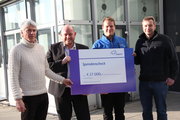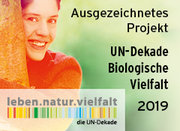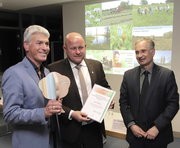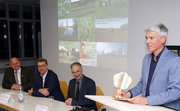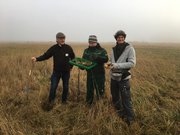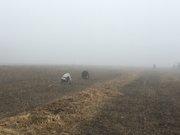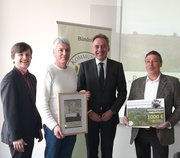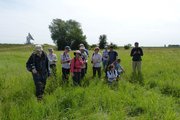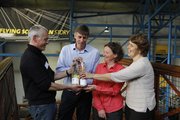Restoration of floodplain meadows along the Hessian Upper Rhine
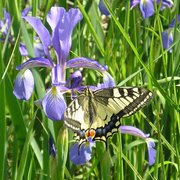
Informations on this website
» In short
» Ecological conditions
» Starting point and aims
» Project area
» Restoration measures
» Agicultural use
» Public relations
» Results / Conclusions
» Further reading
News
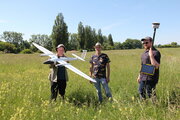
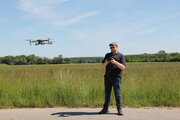
09.06.2021 Drones above floodplain meadows – new assessment of vegetation development on floodplain meadows in Riedstadt
Taking a stroll in the Riedstadt floodplain meadows at the beginning of June one might have come across an unusual sight: Two unmanned aerial vehicles, commonly known as drones, scanning thoroughly some of the meadows from above. One of them being large, with 2.30 m span and looking like a model aeroplane, the second one a considerably smaller quadcopter. Both are used in a new research project on the floodplain meadows in Riedstadt called “Monitoring of species and restoration measures that are important for nature protection through remote sensing” („Monitoring von naturschutzrelevanten Arten und Renaturierungsmaßnahmen per Fernerkundung (MonA).” This project is funded by the Hessian Agency for Nature Conservation, Environment and Geology (https://www.hlnug.de/service/english) with up to 111.850 Euros for three years. A team from Gießen University (Department of Landscape Ecology and Resources Management) under the direction of Prof. Dr. Till Kleinebecker and Dr. André Große-Stoltenberg will gather data by remote sensing to assess vegetation development on restoration areas. More than 20 years ago the City of Riedstadt started together with the federal state of Hesse and local farmers a large scale restoration project in the floodplain of the Rhine. Since then, more than 70 hectares of new floodplain meadows were created (mainly on former arable land, to a lesser degree on species poor grassland) by means of green hay transfer.
The floodplain meadows and the species occurring there are admiringly adapted to changing water conditions with floods on one hand and draught on the other. But as Riedstadt project coordinator Matthias Harnisch points out it seems that the species composition of the meadows might change in consequence of the ongoing climatic changes. As a result of several very hot and dry years it seems that species tolerating wetter conditions as the saw-wort (Serratula tictoria) decline whereas others preferring drier conditions, as the European yellow-rattle (Rhinanthus alectorolophus), proliferate.
“With the help of remote sensing, we want to obtain a better understanding of the vegetation development on our floodplain meadows – for that it is crucial to gather data in different seasons and over a longer time span”, says Harnisch.
This first survey just prior to the first cutting of the meadows focuses on important target species of the floodplain meadows as the blue iris (Iris spuria) which is actually in flower.
Ph.D student Niklas Schepel from Gießen University pilots the quadcopter whose camera can take pictures in high resolution from different angles, from vertically to oblique.
The large drone can cover a wider area, can use thermal lifts and so can stay up to 1 hour in the air whereas the smaller quadcopter needs a newly charged battery every 30 minutes. In addition, the large drone is equipped with a second camera with two infrared channels, which enables to gather data of vegetation density. The data gained by remote sensing allow to drawing an elevation profile of the vegetation, too.
The flight line as well as the picture points are fixed with the help of a software; the pictures are put together afterwards on a computer. “We have a special AI-software for the analyses, but have to train the algorithm first,” explains Große-Stoltenberg.
There are some restrictions that have to be met: The remote sensing has to keep out of areas where there are ground-nesting birds no and flights are allowed in distances less than 1.5 km from Oppenheim Airport. The next flights are scheduled for August 2021.
21.02.2020: The Frankfurt Airport Company (Fraport AG) supports the scientific assessment of the floodplain meadows in Riedstadt with another donation of 27.000 €.
How do climate change and the extremely dry summers 2018 and 2019 affect the floodplain meadows at the northern Upper Rhine, which belong to the most species rich habitats in Central Europe and which are perfectly adapted to changing water levels in the floodplain and to regular flooding? In Riedstadt, this question troubles especially Matthias Harnisch, head of the so called Floodplain Meadow Project, in which the City of Riedstadt, the University of Gießen and the Federal State of Hesse have restored more than 70 hectares of species rich floodplain meadows along the hessian Upper Rhine.
“Especially the falling groundwater levels worry us” explained Harnisch, when Sebastian Linzbauer, representative of Fraport Eco-Fund, visited the Riedstadt town hall to present a cheque of 27.000 euros. This money will be used to assess the impact of climate change on the floodplain meadows, once again in a cooperation of Riedstadt and the University of Gießen. The development of the vegetation on the meadows will be analysed by means of up-to-day technology remote sensing in a succession of flights with a professional unmanned aerial vehicle (UAV).
“We had to learn that there are quite some differences between UAV’s” recalls Riedstadt mayor Marcus Kretschmann smilingly the beginnings of a new project idea. In order to produce sound scientific data an UAV is needed that does not only provide high resolution and multispectral images but also is able to map the ground precisely, explains Prof. Dr. Till Kleinebecker, Head of Department of the Division of Landscape Ecology and Landscape Planning, Justus-Liebig-University Gießen. His department disposes of several UAV’s, one of them a large professional UAV with two cameras, helicopter propulsion system as well as wings of 2 m span with which the UAV can glide and thus remain distinctly longer in air. “To fly such an UAV you need a pilot’s license which five members of our staff already have”, Kleinebecker told. “One flight is nice, but doesn’t really generate useful data”, says Harnisch. Because, in order to assess the vegetation development reliably, it is necessary to collect and analyse remote sensing data over a longer period of time. Thus, the plan is to fly four times a year (once in every season) for three years in succession - the costs for which are estimated with 115.000 Euros, including the analysis of the collected data.
Harnisch is quite confidential to be able to acquire further funding, as the Riedstadt Floodplain Meadow Project is one of the rare long-term restauration projects in Germany and was honoured several times, among others in 2018 as “Project of the year” by the “Alliance municipalities for biological diversity” (only in German). Furthermore, since 2019 it is “Official Project of the United Nations Decade on Biodiversity” (see below).
March 26th 2019: The Floodplain Meadow Restoration Project in Riedstadt is now labelled “Official Project of the United Nations Decade on Biodiversity”. This distinction was presented to the City of Riedstadt within a small ceremony in the Riedstadt city hall on March 26th 2019. Mayor Marcus Kretschmann welcomed the 40 guests, before he looked back on the nearly 20 years of flood plain restoration in Riedstadt and thanked all persons and institutions involved. The Riedstadt project manager Matthias Harnisch then presented the habitat type “floodplain meadows” and gave an overview of the restoration measures undertaken on the hessian Upper Rhine. In his eulogy Professor Dr. Eckhard Jedicke from Geisenheim University emphasised the long-term nature of the project as well as the successful cooperation between nature preservation and farming. Furthermore, he pointed out that Riedstadt, as a funding member of the German "Alliance Municipalities for Biodiversity", shows that it's actually cities and communities that can do a lot to enhance biodiversity on their territories Afterwards, Dr. Christian Hey from the Hessian Ministry of the Environment, Climate Protection, Agriculture and Consumer Protection presented Mayor Marcus Kretschmann and project manager Matthias Harnisch with the certificate “Official Project of the United Nations Decade on Biodiversity”. In his speech, Dr. Hey accentuated that Riedstadt started enhancing biodiversity long before the expression "biodiversity" has got known publicly and that the activities in Riedstadt are highly congruent with the aims of the Hesse strategy on biodiversity.
For further Information about the UN Decade on Biodiversity have a look to www.undekade-biologischevielfalt.de (English version)
18./20.12.2018 Planting of rare floodplain meadow species on restoration areas in Riedstadt and Biebesheim
Within the framework of the project “Preservation of native wildflower species” (“Erhaltungskulturen heimischer Wildpflanzenarten”, website only in German) botanical gardens from all over Germany joined their forces to cultivate rare wildflower species out of autochthonous seeds and then plant them on suitable sites in the landscape. One of these botanical gardens - the botanical garden in Frankfurt - has cultivated 130 blue irises (Iris spuria) out of seeds that were gathered from stands at the Hessian Upper Rhine. In coordination with Matthias Harnisch, the floodplain meadows manager in Riedstadt, 50 of these blue irises were planted on two restoration sites in Riedstadt and Biebesheim.
Apart from these Irises we planted several hundred specimen of saw-wort (Serratula tinctoria) and willow-leaved yellowhead (Inula salicina) as well as mouse-garlic (Allium angulosum). Those three species were grown out of seeds from the hessian Upper Rhine by the University of Giessen.
The restoration site in Riedstadt is an older but still species-poor meadow, where we hope the planting of these rare floodplain-species will help to enhance the development to a species-rich floodplain meadow. The restoration site in Biebesheim, thus, was former arable land on which we already (in October 2018) had applied green hay from old species rich floodplain meadows and now additionally planted these four species in the gaps between the stripes of green hay.
By extending the range of restoration measures further upstream to Biebesheim we aim at an enlargement of the area populated by rare floodplain meadows along the hessian Upper Rhine. With this we hope to lessen the risk of losing this highly endangered habitat type, which according to the German Red List of Habitats is critically endangered and faces total extinction.
The additional planting of rare floodplain meadow species thus supports and completes the restoration of floodplain meadows along the hessian Upper Rhine.
06.03.2018
Together with a pupil’s project from Karlsruhe the Riedstadt floodplain meadow restoration project is distinguished as “Nature Restoration Project 2018” of the “Alliance Municipalities for Biological Diversity”. 47 projects from all over Germany applied for this award that honours exemplary commitment in the field of nature conservation. With the award goes a voucher of 1.000 euros from one large producer of certified regional seeds.
“Offering environmental education for pupils and restoring semi natural habitats in an intensively used agricultural landscape, Karlsruhe and Riedstadt exemplify how municipalities can use local means of action creatively to enhance biological diversity” says Robert Spreter, manager of the Alliance Municipalities for Biological Diversity.
Within the project “Pupils practice nature conservation”, the city of Karlsruhe provides environmental knowledge and offers the experience of nature to fourth-grade primary school students since 2004.
In Riedstadt more than 70 hectares of species rich floodplain meadows have been restored since the year 2000, using green hay from old meadows in nature reserves nearby as source material.
“37 newly established species of the Red List on the restoration sites as well as a large demand for hay on the part of local farmers show us that this combination of land use and nature conservation is economically attractive, too, and creates a win-win-situation for all partners involved” Riedstadt Mayor Marcus Kretschmann and project manager Matthias Harnisch are pleased to state. Further information can be found on the website of the Alliance Municipalities for Biological Diversity.
On the picture, from left to right, Robert Spreter (manager of the Alliance Municipalities for Biological Diversity), Matthias Harnisch (project manager Riedstadt), Peter Gaffert (mayor of Wernigerode and chairman of the Alliance Municipalities for Biological Diversity) and Ernst Rieger (owner of the seed producing company Rieger and Hoffmann). (Thanks for the picture to Katrin Anders, City of Wernigerode.)
June 7th – 9th 2017: Together with director Professor David Gowing ten delegates of the British Floodplain Meadow Partnership (FMP, www.floodplainmeadows.org.uk) were visiting the floodplain meadows along the northern Upper Rhine. The group was guided by Prof. Norbert Hölzel from Münster University and Riedstadt project manager Matthias Harnisch, who prepared also the program of the visit and was in charge of the organisation.
After a short reception by mayor Marcus Kretschmann in the Riedstadt city hall the English colleagues went to the Kühkopf information centre, where they were welcomed by Ralph Baumgärtel, who provided a first impressing overview of the ecological conditions and the history of Hesse’s largest nature reserve. After that, the group took a walk on the Kühkopf to see examples of old alluvial forests as well as the new forest that has been developing after the demolition of the summer dykes in 1983 out of natural succession – one of the really rare possibilities to see an undisturbed by man development of a natural forest in Middle Europe. But of course, the visit on the Kühkopf included different examples of floodplain meadows, too. Apart from an old species-rich meadow the visitors could see different examples of new meadows that have developed since 30 years without further restoration measures just by themselves and a cutting once a year. It could clearly be seen that in spite of favourable site conditions these new meadows are still rather species poor and dominated by common species whereas the rare floodplain meadow species are lacking – and that active restoration is needed to enhance the development of new species rich floodplain meadows.
On the second day of their visit, the FMP delegates went to Leeheim and Erfelden to visit the largest area of species-rich floodplain meadows along the northern Upper Rhine. Here the group could see old meadows in the nature reserves “Riedwiesen von Wächterstadt” and “Bruderlöcher” as well as restored meadows of different age, all situated closely together. Starting with a 1-hectare-pilote-project in 1997 up to now there are more than 70 ha of new floodplain meadows here, the latest restoration measures dating back just to 2016.
The destination of the third and last day of the visit was the nature reserve “Lampertheimer Altrhein” 25 km further upstream, where the group explored old floodplain meadows as well as an restoration area of 10 ha in the vicinity. Here, the Lampertheim project manager Alexander Ochmann explained the measures undertaken to restore floodplain meadows and an alluvial forest in a newly created flooding area that directly connects the Rhine to the old oxbow in the Lampertheimer Altrhein.
The English visitors were amazed by the remains of semi natural landscape in the midst of the densely populated conurbation Rhine-Main-Neckar and by the species richness and diversity of the floodplain meadows here. The English experts were quite astonished that at the northern Upper Rhine floodplain meadows could be found in areas where the groundwater table can fall below 3 metres under surface – as is the case just now. The visitors could so experience one of the main ecological characteristics of the floodplain meadows (and all the landscape) in the region, namely the strong hydrological dynamic with fluctuations with up to 7 m between the lowest and highest water level. This high dynamic is further intensified by the fact that floods at the northern Upper Rhine occur neither frequently, nor always in the same period of the year. In some years, there are no floods at all, in others even more than one and they might occur in autumn, winter, spring or, as the last bigger flooding in 2013, even in summer. This leads to a so-called “concertina-effect” when in dry periods drought-tolerant or –loving species can migrate to lower, potentially wetter elevations and vice versa in wet times. In accordance with that the species tolerating draught are presently better developed than the wet loving ones, even in the lower situated meadows.
Apart from that, the colleagues from the Floodplain Meadows Partnership were deeply impressed by the scale and the success of the restoration measures undertaken in Riedstadt since 20 years. After three intensive days the English visitors went back home to England with a lot of impressions - of which a picnic at the Rhine with some bottles of white wine from the Queen Victoria vineyard was not the least memorable.
9./10.05.2017: At the invitation of the British Floodplain Meadows Partnership (FMP) Riedstadt floodplain meadows project manager Matthias Harnisch has taken part in the conference „Floodplain meadows for the future“ in York. There he presented the restoration and monitoring of floodplain meadows along the Hessian northern Upper Rhine to an audience of 130 participants and visited floodplain meadows in the vicinity of York.
The FMP is an umbrella organization for all beeing concerned with floodplain meadows and their conservation in England and Wales. It is coordinated by the Open University in Milton Keynes under the direction of Professor David Gowing. The FMP collects centrally all relevant data about floodplain meadows - as e.g. vegetation samples, hydrological and soil data - and makes them available for further research and for practical use as the planning of conservation measures and the managing of floodplain meadows.
Since some years there exists a professional exchange between the British experts and the people concerned with floodplain meadows in Riedstadt, which will be deepend further in June, when ten British colleagues will visit the floodplain meadows in Riedstadt.
For further information have a look at: http://www.floodplainmeadows.org.uk
The picture by Dr. Michael Dodd shows (from left to right): Matthias Harnisch (Project manager Riedstadt), Professor David Gowing (Project director FMP), Emma Rothero (Outreach coordinator FMP) und Dr. Irina Tatarenko (Open University Milton Keynes).
April 2014 - June 2014: The Frankfurt Airport Company (Fraport) supports the floodplain meadow projects in Riedstadt with another donation of 10.000,- Euro.The money was handed over on April 7th by the Chairman of the Executive Board of Fraport AG, Dr. Stefan Schulte, and was used for a scientific monitoring of the vegetation on the new meadows. The survey of the vegetation took place in May and June 2014 and was carried out by Polish botanist Dr. Dorota Michalska-Hejduk, who has assessed the vegetation an 150 permanent plots of 10 to 10 m as well as on 10 restoration areas in the whole. The monitoring shows that the restoration of floodplain meadows in Riedstadt was extremely successful and that the new meadows are very specious rich, including many endangered and protected species.
February, 20th 2014: Release of the specialist book "Restoration of floodplain meadows with green hay transfer". The book was written by Matthias Harnisch, project coordinator in Riedstadt, Tobias w. Donath, Ralf Schmiede and Annette Otte (all: University of Gießen) and was edited by the renowned publishing house Ulmer in Stuttgart. For further information, extract reading or ordering have a look at the website of Ulmer's here
March, 7th 2013: A new flyer about the floodplain meadows project was released (download here (pdf), only in german)
March, 5th 2013: Together with a delegation of politicians and experts the minister for the environment of the Georgian Republic, Miss Khatuna Gogaladze, informed herself about the floodplain meadows restoration projects in Riedstadt.
Contact / Reference
Text, Cartography and Pictures, where not otherwise marked: © Matthias Harnisch, City of Riedstadt
Unauthorized use of pictures and text - in whole and partially - without official consent of the authors and without naming the authors is not permitted.
Matthias Harnisch
City of Riedstadt
Rathausplatz 1
D-64560 Riedstadt
Telephone: 0049 - (0)6158 - 181322
eMail: Matthias Harnisch, Riedstadt


